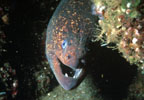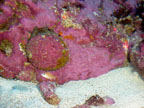|

|
The Channel Islands
are breeding grounds for both common and
endangered species. The Xantus's murrelet
(Synthliboramphus hypoleucus) whose
population is less than ten thousand only
breeds at the Channel...click image for
more..(photo: Channel Islands
NMS)
|
|

|
The Brown Pelican
(Pelecanus occidentalis), an
endangered species, feeds on schooling
fish near the ocean's surface by plunging
beak-first from the air. The chemical DDT
almost caused the demise of the brown
pelican....click image for more...
(photo: Shane Anderson)
|
|

|
While one may likely
see birds flying within the CINMS
boundaries, one may also see dolphins
"flying" out of Sanctuary waters. The
common dolphin (Delphinus delplu)
is the most abundant ...click image for
more... (photo: Shane
Anderson)
|
|

|
The most abundant
pinniped (seals and sea lions) in the
Sanctuary is the California sea lion
(Zalophus californianus). Over
80,000 California sea lions live and breed
in the Channel Islands. Sea lions live in
herds and can weigh up to 700 pounds! One
will usually see these playful mammals
basking in the sun on shore or playing
with other sea lions underwater. (photo:
Glenn Allen)
|
|

|
The blue whale
(Balaenoptera musculus) is a member
of the cetacean family and with fewer than
10,000 individuals it is considered
endangered. This is the largest species
ever to exist (even bigger than
dinosaurs!) ...click image for more...
(photo: Fred Benko)
|
|

|
Not as big as the
dinosaurs, but possibly as old, sharks
first appeared 450 million years ago! More
than 25 species of sharks inhabit the
waters of the Channel Islands. Unlike
fish, sharks lack bony skeletons, scales
and air bladders. By day, blue sharks
(Prionace glauca) are a common
resident offshore, often visible from
boats cruising the channel. By night, blue
sharks move inshore to feed on anchovies
and squid. (photo: Shane
Anderson)
|
|

|
The abalone
(Haliotis sp.) belongs to the
phylum Mollusca, which is even older than
that of the shark-molluscan fossil records
have been dated back to over 500 million
years. Different species of abalone can be
found from ...click image for more...
(photo: Glenn Allen)
|
|

|
In addition to being
a food source for abalone, fish and
invertebrates, kelp forests
(Macrocystis pyrifera) provide
shelter for many marine organisms. Factors
such as these make kelp an extremely
important part of the Channel Islands
ecosystem, which is surrounded by beds of
giant kelp. (photo: Kip Evans)
|
|

|
Giant kelp
(Macrocystis pyrifera) is the
world's largest marine plant, growing as
much as 50-60 cm (20-25 inches) per day!
During favorable oceanic conditions, when
water temperatures are a cool 50° -
65° F and ...click image for
more... (photo: Shane
Anderson)
|
|

|
A common resident
found in kelp beds, rocky shores, and
coral reefs is the sea urchin. It has a
healthy appetite for organic material and
feeds on kelp as pieces drift by. Sea
urchins like this Purple Sea Urchin
(Strongylocentrotus purpuratus) can
...click image for more... (photo:
Laura Francis)
|
|

|
Another reef
inhabitant is the anemone. Some species,
such as the brooding anemone (Epiactus
prolifera) shown here, carry their
young on the outside of the body. Anemones
rely on stinging cells located in their
...click image for more... (photo:
Shane Anderson)
|
|

|
Another unique
organism is the feather duster worm
(Eudistylia polymorpha). Believe it
or not, this beautiful species is not a
plant, it's a worm. Its feathery plumes
are used to filter water for nutrients and
will retract into its tube when it is
disturbed. (photo: Chris
Gotschalk)
|
|

|
Like the feather
duster worm, the brittle star
(Ophiuroidea sp.) also filters its
food using its tube feet. They play a
vital role in the food chain by eating
organic wastes from the ocean floor,
helping to recycle nutrients. ...click
image for more... (photo: Shane
Anderson)
|
|

|
A sea star also uses
its tube feet to feed on sediments,
bivalves, fish and even other sea stars!
These active scavengers are found on both
sandy bottoms and rocky reefs. The blood
star (Henricia leviuscula) is
particularly fond of ..click image for
more...(photo: Laura
Francis)
|
|

|
Bryzoan (Costazia
costazi) species are often confused
with coral. However, bryozoans comprise a
unique phylum of colonial invertebrates
otherwise known as "moss animals".
...click image for more... (photo:
Shane Anderson)
|
|

|
While bryozoans may
be found growing on some species of crab
for camouflage, the sheep crab
(Loxorhynchus grandis) (shown here)
does not use other organisms to mask its
appearance. The sheep crab is another
...click image for more... (photo:
Shane Anderson)
|

|
Both lobsters and
crabs are within the subphylum Crustacea
of the phylum Arthropoda. California spiny
lobsters (Panulirus interruptus)
lack the large pinching claws of their
Maine lobster relatives. California spiny
lobsters...click image for more...
(photo: Shane Anderson)
|

|
Many species of
rockfish inhabit the waters of the Channel
Islands. Treefish (Sebastes
serriceps) generally live in rocky
crevices and caves of depths up to 46
meters (150 feet). Treefish are extremely
territorial and their red-colored lips are
probably used to scare off other fish.
(photo: Chris Gotschalk)
|
|

|
Garibaldi - This
fish the Garibaldi (Hypsypops
rubicundus) is lucky enough to be
protected not only within the boundaries
of our marine sanctuaries, but by
California state law as well. They are
intensely curious about divers and are
...click image for more... (photo:
Channel Islands NMS)
|
|

|
Red Urchin - This
urchin, the red urchin
(Strogylocentrotus franciscanus) is
the largest species of urchin, growing up
to 7 inches in diameter and can survive
for up to 20 years. Red urchins are
grazers whose appetite for kelp play a
significant role in the overall ecology of
kelp forest and reef communities.(photo:
Channel Islands NMS)
|
|

|
Pink Abalone - Pink
abalone (Haliotus corrugata) are
the easiest abalone to identify due to the
design you can find along the edge of the
shells and their dark black tentacles. The
pink abalone generally inhabit areas from
the inter tidal zone to 200 feet.(photo:
Channel Islands NMS)
|
|

|
Moray Eel - Because
they lack gills moray eels (Gymnothorax
mordax) constantly open and
close their mouth in order to breathe.
This habit has a tendency to showcase the
moray's fang like teeth and has lead to
exaggerated fears of a creature that is
typically very shy around humans.
...click image for more... (photo:
Brandon Cole)
|
|

|
Gopher Rockfish -
These fish can reach a length of up to
15.5 inches and can live for up to 13
years! Generally gopher rockfish
(Sebastes carnatus) can be found
between Mendocino County (Northern
California) and Santa Monica Bay where
they snack on some of their favorite meals
like zooplankton, crab larvae and
crab.(photo: Brandon Cole)
|
|

|
Blacksmith -
Blacksmith (Chromis punctipinnis)
live in loose schools which when being
cleaned by parasite eating fish, form a
tight ball and hang upside down, each fish
waiting it's turn to be cleaned. The
blacksmiths themselves like to munch on
zooplankton, copepods, crustacean larvae
and eggs.(photo: Dan Richards)
|
|

|
Senorita - This
fish, the Senorita fish (Oxyjulius
californica) gets it's food in an odd
way: it preys upon the parasites that
attach themselves to fish. This
arrangement not only benefits the senorita
fish, which receives a meal, but also the
other fish which rids itself of
undesirable parasites. (photo: Dan
Richards)
|
|

|
Bat rays
(Holorhinus californicus) like this
one are truly graceful creatures who are
normally 4 to 5 feet across but have been
reported with "wingspans" of 8 feet. They
live up to 24 years and are armed with a
defensive barb on the end of their tail.
Female bat rays grow larger, are faster,
and live longer than males.(photo: Channel
Islands NMS)
|
|

|
California Sheephead
- You might find a California sheephead
(Pimelometopon pulchrum) like this
one roaming the rocky reefs and kelp
forests that line the shore from the
Channel Islands to Monterey. ...click
image for more... (photo: Channel
Islands NMS)
|
|

|
Sand Star - Sand
stars (Astropecten foliota) can be
recognized by the rows of spines along the
margins of their arms and can attain a
diameter of up to 10 inches. They range
from the Channel Islands to Ecuador and
eat a variety of foods including snails,
dead fish, sand dollars, clams, other sea
stars, and sea urchins.(photo: Channel
Islands NMS)
|
|

|
Torpedo Ray -
Torpedo rays (Torpedo californica)
are identifiable by their flat gray bodies
and black spots Interestingly these
animals catch their prey by stunning them
with a jolt!(photo: Daniel
Gotshall)
|
|

|
Starry Rockfish -
Starry rockfish (Sebastes
constellatus) are beautiful fish that
are colored red-orange with yellow and
white spots. They are located from
Northern California to Southern Baja
California and live exclusively over hard
bottoms, around large rocks, or in
crevices. ...click image for more...
(photo: Daniel Gotshall)
|
|

|
Blue Rockfish - Blue
rockfish (Sebastes mystinus)swim in schools of hundreds or
thousands over reefs and around kelp where
they feed upon zooplankton, jellyfish,
krill, kelp and hydroids.(photo: Daniel
Gotshall)
|
|

|
White Abalone - This
white abalone (Haliotus sorenseni)
is known for it's yellow tentacles and
bright orange foot, which it uses to
capture and then eat drifting algae with.
White abalone are generally found at
depths beyond 100 feet.(photo: Channel
Islands NMS)
|
|

|
Green Spotted
Rockfish - The green spotted rockfish
(Sebastes chlorostictus) can be
found living in almost any habitat from
rocky bottom to sand and mud, from
vertical faces to horizontal plains. They
are considered solitary species, and spend
most of their time on or near the bottom
where they mainly prey upon invertebrates
such as crab and shrimp.(photo: Channel
Islands NMS)
|
|

|
Giant Sea Bass -
Giant sea bass (Stereolepis gigas)
are mainly bottom dwellers, but will come
into mid waters when searching for food.
They were once abundant throughout Baja,
before they were over-fished. They eat
spiny lobsters, rock crabs, and
squid.(photo: Mark Conlin)
|